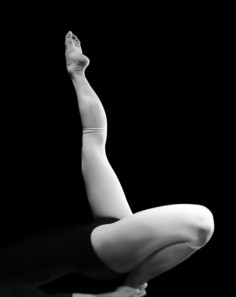Sara VanDerBeek
Baltimore Dancers Nine

source: saatchigallery
Sara VanDerBeek is the first to acknowledge the influence of an artistic family: Stan VanDerBeek, her experimental, surrealist-inspired film-maker father, and Johannes VanDerBeek, her sculptor brother. All seem to share a lively curiosity, a spirit of inventiveness and idealism. So it is not surprising that VanDerBeek lists her concerns as “memory, experience, inspiration and influence”, resulting in assemblages of found images and objects which she photographs in her studio and presents in final form as framed photographic prints.
The assemblages themselves may include magazine pages, family snapshots, bits of fabric, string, rods, plaster casts, and so on. Calder and Brancusi make their spirits felt, while the sense of suspended animation and randomness echo the films of her father. The fragile constructions seem to be no more than momentary constellations – at any second they might blow away like leaves in the autumn wind. Neither Mrs Washington’s Bedroom nor The Field-Glass has any more solidity than a dream. Despite photography’s desperate attempt to nail them down, these will always be works in progress.
.
.
.
.
.
.
.
source: moussemagazineit
Sara VanDerBeek continues to explore the relationship between photographic imagery and sculptural forms. In the past VanDerBeek’s sculptures were constructed only to be photographed, but more recently and for this exhibition, she presents sculptures in the gallery together with her photographs.
VanDerBeek began by collaborating with three dancers in her hometown of Baltimore, Maryland. She worked with them on the actions and phrases of certain improvised dances, directing them to explore lines and angles, before choreographing and capturing selected movements as photographs. In parallel she created a number of stacked plaster sculptures, each composed of a single symmetrical unit that repeats fluidly throughout the structure. The configuration of form and pattern within each sculptural work, and their arrangement throughout the gallery space, creates a direct relationship to the form and rhythm of the dancer’s bodies in the photographs.
Just as VanDerBeek composed and captured objects in the studio, the bodies in these photographs are also realized as shapes and form. However, in contrast to the construction of earlier works, the dancers encourage an element of chance and sense of movement to enter into the compositions. The way the dancer’s bodies are reflected in the black space of the dance floor is echoed in the mirrored shapes of the stacked plaster blocks that stand like figures with their imperfect yet distinct symmetry. Despite the obvious static physical state of the photos and sculptures, movement is suggested. The potential energy of the dance is equally evident in the captured dance movements as it is in the rhythm of line, space and form in the sculptures, both individually and as a group. The photographs are the transient capturing of a moment passed and the sculptures are a permanent incarnation.
In certain ways, the fabrication of the sculptures after the photographs were taken is an inverse of her original practice, where the sculpture was the starting point that was photographed and then absent. This new process highlights VanDerBeek’s continuing exploration of the transitive state of both mediums. A transition into presenting sculptures with her photographs began for VanDerBeek during the course of two recent projects. In 2010, she created an installation of images at the Whitney Museum of American Art, entitled “To Think of Time” inspired by Walt Whitman’s poems from his seminal book “Leaves of Grass”. Finding and framing compositions within the architecture of several American cities, as well as constructing images in her studio, the work for this exhibition was a meditation on change. Several of the images portrayed similar structures to those included in this exhibition. Last year at the Hammer Museum in Los Angeles, she exhibited sculpture as part of an installation that included images and objects that were created in response to her residency at the museum.
In all of her works, past to present, translating an experience, a memory, a space through images, forms the foundation of VanDerBeek’s practice. Whether in states of action or stasis there is a fascination with the relationship between photographic image and object, the architecture of the cities and bodies in which we live and occupy and the universality of these subjects she chooses to explore.
.
.
.
.
.
.
source: fabrikla
Sara VanDerBeek was born in Baltimore, Maryland in 1976 and currently lives and works in New York City. She has had solo shows at the Hammer Museum, Los Angeles; Metro Pictures, New York; Altman Siegel Gallery, San Francisco; Whitney Museum of American Art; and The Approach, London. Her work has been exhibited at many international institutions including the Museum of Contemporary Art, Los Angles; the Los Angeles County Museum of Art, Los Angeles; Guggenheim, New York and Bilbao; Museum of Modern Art, New York; and the Hirshhorn Museum, Washington D.C., all of which have included her work in their permanent collections. VanDerBeek is represented by Metro Pictures in New York and The Approach in London.

